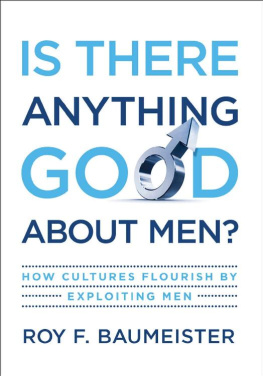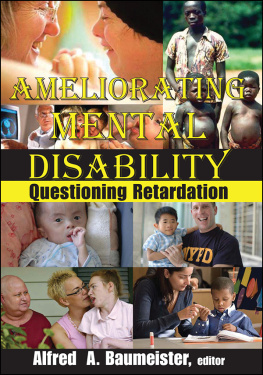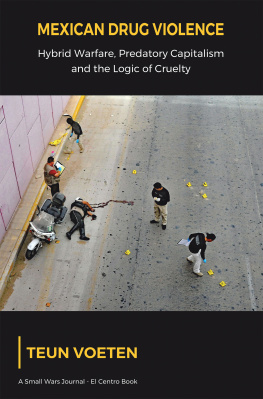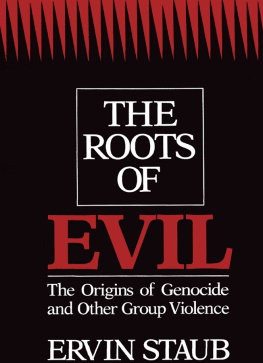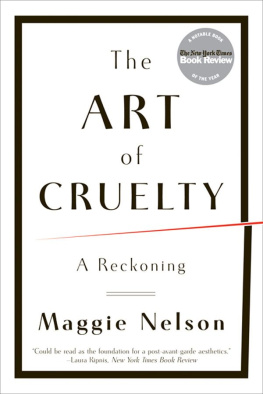Roy F. Baumeister - Evil: Inside Human Violence and Cruelty
Here you can read online Roy F. Baumeister - Evil: Inside Human Violence and Cruelty full text of the book (entire story) in english for free. Download pdf and epub, get meaning, cover and reviews about this ebook. year: 1997, publisher: Henry Holt and Company, genre: Science. Description of the work, (preface) as well as reviews are available. Best literature library LitArk.com created for fans of good reading and offers a wide selection of genres:
Romance novel
Science fiction
Adventure
Detective
Science
History
Home and family
Prose
Art
Politics
Computer
Non-fiction
Religion
Business
Children
Humor
Choose a favorite category and find really read worthwhile books. Enjoy immersion in the world of imagination, feel the emotions of the characters or learn something new for yourself, make an fascinating discovery.
- Book:Evil: Inside Human Violence and Cruelty
- Author:
- Publisher:Henry Holt and Company
- Genre:
- Year:1997
- Rating:4 / 5
- Favourites:Add to favourites
- Your mark:
- 80
- 1
- 2
- 3
- 4
- 5
Evil: Inside Human Violence and Cruelty: summary, description and annotation
We offer to read an annotation, description, summary or preface (depends on what the author of the book "Evil: Inside Human Violence and Cruelty" wrote himself). If you haven't found the necessary information about the book — write in the comments, we will try to find it.
Evil: Inside Human Violence and Cruelty — read online for free the complete book (whole text) full work
Below is the text of the book, divided by pages. System saving the place of the last page read, allows you to conveniently read the book "Evil: Inside Human Violence and Cruelty" online for free, without having to search again every time where you left off. Put a bookmark, and you can go to the page where you finished reading at any time.
Font size:
Interval:
Bookmark:
and Cruelty
A W. H. Freeman / Holt Paperback
Henry Holt and Company New York
Thank you for buying this
Henry Holt and Company ebook.
To receive special offers, bonus content,
and info on new releases and other great reads,
sign up for our newsletters.

Or visit us online at
us.macmillan.com/newslettersignup
For email updates on the author, click here.
The author and publisher have provided this e-book to you for your personal use only. You may not make this e-book publicly available in any way. Copyright infringement is against the law. If you believe the copy of this e-book you are reading infringes on the authors copyright, please notify the publisher at: us.macmillanusa.com/piracy.
When I first saw Professor Baumeisters book in a bookstore, I was immediately attracted to it. I knew Id be in for a treata fresh approach to an overworked but underdeveloped problem. When I read his volume from cover to cover I thought Here is a person who can present an original approach to complex concepts in language that the average curious reader, as well as the scholar, can understand and enjoy.
More-or-less by coincidence, Roy Baumeister and I have written books on a topic that affects every person on the planet: mans inhumanity to man. Although our approaches overlap a good deal, they also compliment each other. Here I will expand a bit on Baumeisters ideas, to provide a broader context for the readers of this excellent book.
In trying to understand a topic as broad and complicated as anger, hostility, and violence, it is important to realize that there are different levels of analysis. To comprehend these phenomena more fully, the reader or scholar needs to have not only a grasp of these levels but also some idea of how they interact with one another. Take the example of the causation of war. This can be analyzed from the standpoint of the supranational system (competition, the security dilemma, balance of power) leading to preemptive strikes by a threatened or expansionist state. The precipitation of war can be analyzed in terms of individual states with their own idiosyncratic histories, attitudes and economics, social, and military power. Or the analysis can be directed to the psychology of the political elite with their own drives for power and prestige and the populace with its loyalty and dreams of glory.
Professor Baumeister has succeeded admirably in applying the tools of social psychology and history to understand the causes of evil behavior. My approach has focused more narrowly on the minds of those who make the decisions to wage war and of those who follow. In many wars, the decision-makers make what they consider rational choices in moving toward or avoiding armed conflict. Their followerswho make the sacrificesare stirred by the highly charged, emotionalized beliefs, group empathy, and heroism that Baumeister describes (these positive merits fade in time when disillusionment replaces the illusions). The critical factor is their unlimited capacity to see the opposition as the Enemy, as all bad, and their own national state as righteous and all good. The various levels interact with one another. The chaotic supranational system, say, produces insecurity among the states. This leads the governments to engage in an arms race. The apparent threat to the national state filters down to the populace, who rally round the flag to protect the national honor. The interaction among the levels can go in both directions.
Just before the Spanish American War there was a great instability in the crumbling Spanish Empire. The rebellions, especially the suppression of the rebels in Cuba and in the Philippines, captured the imagination and sympathy of the American people. The populace and its representatives in Congress perceived the Spanish as the enemy, the Cubans and the Filipinos as the vulnerable underdogs, and the Americans as the champions of the oppressed. Thus, the people, as a result of their images, brought pressure on a reluctant President McKinley to go to war. The vivid imagery of the masses prevailed over the judgment of the statesmen.
In examining violent behavior it is also important to make a distinction between the predisposition to violence and the precipitation of violence. An appreciation of the difference can lead to quite different intervention strategies.
Consider domestic violence in terms of these two approaches. From the standpoint of predisposition, the predominant culture or community values may present the image of the macho male and the subservient female. This value may be translated into bold beliefs, perhaps that the wife should accede to her husbands judgment and wishes. At the level of the family of origin, the beliefs communicated by the interaction between the parents may either reinforce or undermine this belief. Also the behavior of the father may communicate the notion that violence is the only way to silence a scolding wife. This belief may also originate with or be reinforced by the peer group. The next level is the adversarial relationship of husband and wife. A history of escalating arguments, increasing tension, verbal arguments and threats generally provides the prelude to physical violence. At the level of the violent husband, a number of beliefs (many filtered down from higher levels) may converge to prepare him for violent action. Among these: 1. A wife who continually pesters her husband is a shrew 2. Nagging at her husband is a sign of disregard 3. The only way to shut her up is to punch her in the mouth; and at a less conscious level, 4. If I let her get away with it, Im less of a man.
The precipitation of an assault may be related to higher level events such as economic instability leading to job insecurity leading to a greater sense of vulnerability, worry, and anxiety. Overdosing on alcohol to salve the anxiety, coupled with one more argument, may activate all the aforementioned beliefs and thus precipitate the man beating his wife.
Labels like Evil and the Enemy are actually abstractions (which is the reason that I capitalize the first letters of these words). Assaulters, offenders, batterers, crusaders, perpetrators conjure up images of Evil and the Enemy they then project onto their opponent or antagonistswho are often weak and vulnerable. As Professor Baumeister points out: whoever opposes you or blocks your own good work is an Enemy of the Good and is therefore Evil.
Professor Baumeister also focuses sharply on the major causes of violence and cruelty, which he neatly organizes into three categories. The first is the desire for material gain (I would also include the lust for power and self-aggrandizement in this category). This instrumental cause has driven the great conquerors of history from Cyrus the Great to Hitler. Perhaps the most original of his ideas involves the following notion: When someone with an overblown sense of self-worth fears a threat to his self-esteem, a kind of reflexive hostility can result: Stop the threat before it inflicts damage. The person feels diminished in some way (rejected, devalued, exploited) and is driven to punish the offender. Examples range from a husband who beats his wife because she criticizes him, to a monarch like Louis Napoleon who was insulted by a note contrived by Bismarck and in retaliation declared war on Prussia. The third source of violence is idealism and utopianism, with examples that range from the lone anarchist or militant with a bomb, to religious movements like the Crusades, to genocides like the Holocaust, to mass murders in Maos China, Stalins Soviet Union, and Pol Pots Cambodia.
Font size:
Interval:
Bookmark:
Similar books «Evil: Inside Human Violence and Cruelty»
Look at similar books to Evil: Inside Human Violence and Cruelty. We have selected literature similar in name and meaning in the hope of providing readers with more options to find new, interesting, not yet read works.
Discussion, reviews of the book Evil: Inside Human Violence and Cruelty and just readers' own opinions. Leave your comments, write what you think about the work, its meaning or the main characters. Specify what exactly you liked and what you didn't like, and why you think so.


